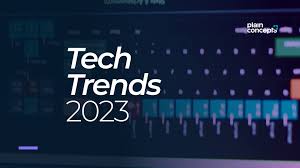
Be a force to reckon with in the world of tech by mastering any of the 7 top trending tech courses I would be writing on in this article. If you are looking into mastering any tech skills to make you outstanding, then, you are in the right place. This article will help shed more light on these and the reasons why you have to go into them.
7 Top Trending Tech Courses in 2023
Below are at least 7 tech courses you can master and are currently trending in the year 2023. They are:
Business Intelligence
Business intelligence (BI) refers to the tools, techniques, and systems that are used to collect, integrate, analyze, and present data and information to support decision-making in an organization.
BI can help organizations gain insights into their operations, customers, and other areas that can help them improve their performance and achieve their goals.
Some common components of BI systems include data warehouses, data visualization tools, dashboards, and reporting systems.
These tools can help organizations to identify trends, patterns, and relationships in their data, and use that information to make informed decisions and take strategic actions.
Internet of Things
The Internet of Things (IoT) refers to the connection of devices (other than traditional computers and smartphones) to the internet, allowing them to send and receive data.
These devices can include things like home appliances, vehicles, and other objects embedded with sensors and electronics that allow them to collect and exchange data.
The goal of the IoT is to allow these devices to communicate with each other and with other systems over the internet, enabling them to be controlled and monitored remotely, and making it possible to automatically collect and analyze data from these devices to improve efficiency and productivity.
Blockchain
Blockchain is a distributed database that is used to maintain a continuously growing list of records, called blocks. Each block contains a timestamp and a link to the previous block.
Blockchain technology is useful for recording transactions because it is secure and transparent. It is also decentralized, meaning that it is not controlled by any single entity, but rather it is maintained by a network of computers that work together to validate transactions and add new blocks to the chain.
This makes it difficult for any single block to be altered because doing so would require the consensus of the entire network.
Some common uses of blockchain technology include the recording of financial transactions, the creation of smart contracts, and the tracking of the movement of goods or other assets.
AI and Machine Learning
Artificial intelligence (AI) and machine learning (ML) are closely related and often used interchangeably. At a high level, AI refers to the ability of a machine to perform tasks that typically require human-like intelligence, such as understanding language, recognizing images, or making decisions.
Machine learning is a subfield of AI that involves training a computer to perform these tasks without being explicitly programmed to do so.
In machine learning, a model is trained on a large dataset, and then makes predictions or decisions based on that training. For example, a machine learning model might be trained on a dataset of customer data to predict which customers are likely to churn.
After training, the model can then make predictions for individual customers, given their characteristics.
There are many different techniques and approaches for training machine learning models, including supervised learning, unsupervised learning, and reinforcement learning. The choice of technique depends on the nature of the task and the available data.
Metaverse
The term “metaverse” refers to a collective virtual shared space, created by the convergence of virtually enhanced physical reality and physically persistent virtual space, including the sum of all virtual worlds, augmented reality, and the internet.
The concept of a metaverse has been inspired by science fiction and has been depicted in various forms of media, such as novels, movies, and video games.
Some examples of metaverse environments include virtual reality (VR) and augmented reality (AR) systems, online gaming worlds, and other virtual communities.
The concept of a metaverse is still largely theoretical, but many people believe that it has the potential to revolutionize the way we interact with technology and with each other.
Cloud Computing
Cloud computing is a model for enabling ubiquitous, convenient, on-demand network access to a shared pool of configurable computing resources (e.g., networks, servers, storage, applications, and services).
It allows users to access computing resources on demand, without having to purchase and maintain physical infrastructure. Instead, users can pay for what they use on a pay-as-you-go basis, or subscribe to a service regularly.
Cloud computing enables users to access data, applications, and services from anywhere, at any time, from any device. It can be delivered in a variety of ways, such as through a public cloud, a private cloud, or a hybrid cloud.
Augmented and Virtual Reality (AR and VR)
Augmented reality (AR) and virtual reality (VR) are two closely related technologies that have the potential to revolutionize a wide variety of fields, from entertainment and gaming to medicine, education, and beyond.
AR involves superimposing computer-generated images or information onto the real world, often in real-time, using devices such as smartphones or specialized glasses.
This can be used to enhance or enrich our perception of the world around us, by providing additional context or information about what we are seeing.
VR, on the other hand, involves creating a completely immersive, computer-generated environment that users can interact with in a seemingly real or physical way.
This is typically achieved using a headset that blocks out the outside world and provides a 3D visual and auditory experience.
Both AR and VR have a wide range of applications and are already being used in fields such as gaming, entertainment, education, and training. They also have the potential to be used in fields such as healthcare, architecture, and retail, among others.

Why You Have to Master these Top Trending Technologies in 2023
There are several reasons why it is important to be tech-savvy in the currently trending tech courses:
- Tech skills are in high demand: Many industries are looking for people with technical skills, and the demand for these skills is only expected to grow in the coming years.
- Better job opportunities: Being tech-savvy can give you a competitive edge in the job market and may lead to better job opportunities and higher salaries.
- Staying current: The tech industry is constantly evolving, and staying up-to-date with the latest trends and technologies is essential to remain competitive in the field.
- Improved problem-solving skills: Tech courses often involve problem-solving and critical thinking, which can help you develop valuable skills that can be applied in various areas of your life.
- Improved communication skills: Tech courses often involve working in teams, which can help you improve your communication skills and work effectively with others.




